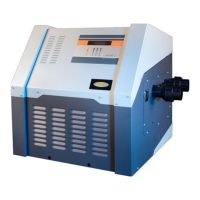- 12 -
INST 396 Jacuzzi® J-HN Series Heater V12-16
INSTALLATION
WARNING: THIS APPLIANCE MUST BE INSTALLED BY A LICENSED AND BONDED POOL EQUIPMENT INTALLERS.
AUTHORISED PERSON. Refer to heater data plate for specifications of gas type, gas consumption, burner pressure and water
pressure.
This appliance must be installed in accordance with local regulations and
For a heater in which no provision is made for a vent permanently open between the water circuit and atmosphere a pressure relief
valve must be fitted in accordance with
LEVELLING OF THE HEATER
With OUTDOOR Installations it is advisable to have the Heater Level from left to right across the heater and have it slightly angled
(approx. 5º) to the rear to help with drainage of the Flue from water after rain.
FLOW RATES
The Jacuzzi® J-HN Series Heater requires a minimum of 31Gallons (120 liters) per minute (254 ft
3
/h)(7.2 m3/hr) and a maximum
flow rate of 132 Gallons (500 liters) per minute (1059 ft
3
/h) (30 m3/hr). It is recommended that an external bypass valve capable of
bypassing some water be installed when flow rates exceed 99 gallons (375 liters) per minute (794 ft
3
/h) (22.5 m3/hr).
WATER CONNECTIONS
The heater should always be installed after the pump and filter. The water connections are located on the right hand side of the
heater. The inlet and outlet are clearly marked. Water connections require 2” high pressure PVC glue-in plumbing. It is
recommended that Class 12 (PN12) pipe be used to connect to the heater.
All automatic sanitising devices must be installed after the heater and in such a way that the sanitiser cannot enter the heater
without first mixing with the water in the pool or spa. Sanitisers that are connected prior to the heater will void heater warranty.
A non-return valve is not required to be fitted between the filter and the heater.
GAS SUPPLY LINE INSTALLATION
Check heater rating plate to verify the type of fuel gas your heater is equipped to burn. Generally, natural gas is supplied at a lower
pressure from the local gas utility and requires larger diameter piping than a propane installation. Propane (LPG) typically requires
the installation of a storage tank, and often the LPG supplier will size and place the tank and the required LPG regulators and piping.
Consult your local LPG supplier for assistance with your LPG installation. The pipe sizing charts that follow are all based on Natural
Gas with a specific gravity of 0.65, and Propane (LPG) with a specific gravity of 1.55.
The utility provided (natural gas) meter in new construction is often a source of excessive pressure loss unless sized for the
additional load of a pool heater used in combination with all other appliances in the home (being supplied from the same line).
Consult your local natural gas company.
Generally, the longer the piping run, the higher the pressure drop (loss). Usually based on your delivery pressure (at your utility
supplied as meter and house gas pressure regulator) as a starting point pressure. Larger diameter piping, while costly, has less
frictional gas pressure losses than smaller piping. The pipe sizing tables that follow are based on piping downstream (after) your gas
meter running up to the heater. Elbows are a costly source of pressure drop (loss), each being equivalent to the loss from 3
additional feet of straight piping. So minimise their use. Step the piping size down as close to the heater as possible.
The Jacuzzi® J-HN series heater requires a minimum supply pressure of 5 in w.c. for natural gas and 11 in w.c. for propane (LPG).
These pressure (dynamic pressure) must be verified under load (heater fired) as an incorrect reading (static pressure) wil be
obtained with heater off. The heater may not operate correctly without proper gas supply pressure (see page 32 for further
details.)
All the gas supply piping installation must conform to all local codes, and must conform to the requirements of the latest edition of
the National Fuel Gas Code ANSI Z223.1/NFPA 54 for US installations, or in Canada with the latest edition of CSA B149.1, Natural
Gas and Propane Installation Codes.
Always install a manual shut-off valve (gas cock) and sediment trap outside of the heater cabinet – immediately before gas line enters
heater. Do not install a gas line union inside heater cabinet
.
The piping installation must be tested for leaks and is typically tested at pressures above ½ psig – therefore piping must be isolated
from other gas appliances in use during pressure testing. Check with your local gas company or local building code inspection
department for local code requirements.

